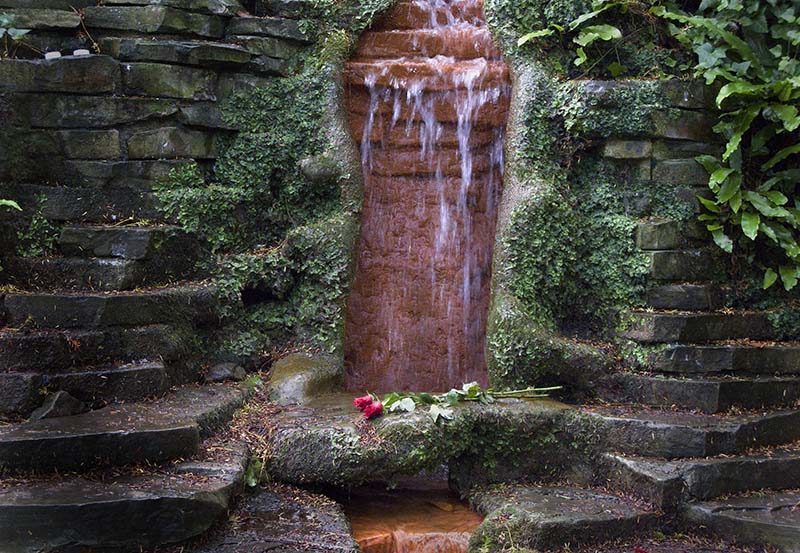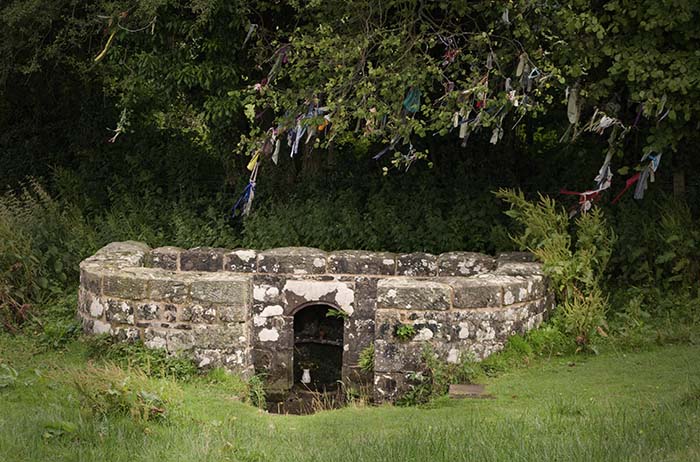SACRED SPRINGS AND HOLY WELLS.


Springs were particularly revered as the elixir of the Earth since the waters that emanate from their depths have been touched the least by the crude matter of the exterior world. They carry the memory of the womb of the Earth Mother in its pristine state.
This understanding has survived in the folklore of ancient cultures for thousands of years. The reverence of the sacred spring went beyond maintaining the purity of water: the equilibrium of the individual, the tribe, even the immediate landscape depended on the purity and sanctity of this elixir.
In many parts of Europe the tradition of honouring sacred springs was maintained well into the Medieval era, when permanent stone structures were erected over springs so as to maintain the purity of the water. Research shows that the stone used for well housings emits a natural radiation that actually keeps harmful bacteria away.
As the Catholic church supplanted the Celtic system, so the holy wells became Christianized. Local pagan deities were changed to reflect their new master, for example, wells once dedicated to the goddess Morgana were changed to Mary. The church also adopted the use of holy water from pagan cultures by bringing it into the church in the shape of the font, even if it today it is merely a symbolic gesture.
However, it is interesting to note that in older Celtic Christian churches the fonts, which traditionally sit in the western part of the buildings, were placed over blind springs. These naturally occurring subterranean vortices are generated by the movement of water as it passes through fissures below the soil. Since blind springs tend to attract lines of magnetic force, the rising vortex is highly charged. As it rises to the surface the energy penetrates the granite of the font and its inherent quartz crystal.
Quartz is a wonderful memory storage device, so the energy upwelling from the earth charges the water in the font, literally making it whole — w-holy water.
Sacred springs are also protected by prayers and offerings. The continual reinforcement of the spirit of place maintains the purity and effectiveness of the elixir flowing out of the Earth. Recent scientific experiments of the Japanese scientist Masaro Emoto show how human intent has a profound affect on the shape and crystalline structure of water, proof that prayers and words of veneration, particularly aimed at water, will alter its properties.
In the Victorian era patients were referred by their doctors to travel to the countryside to find cures for ailments in holy wells and sacred springs far from major cities, after all, this had been the practise for thousands of years, and local traditions referred patients to wells with specific cures. Some for eyes, others for gout, liver, rheumatism and so on.
One famous case history comes from 1640, of a man named John Trelille, who wasborn with twisted limbs, and for the best part of sixteen years was paralyzed. After experiencing a prophetic dream, he crawled around Madron Well three times, then bathed in its waters and slept over its underground stream. In the following days he gained strength and was completely cured of the knotted sinews of his limbs, in fact he went on to enlist in the King’s Army, and served gallantly.

Clether’s Well, Cornwall, a classic example of a well house protecting the purity of water.
The ritual use of the hot mineral springs at Bath, England appears to have begun at least 10,000 years ago and continues to present times.
First frequented by Neolithic hunter-gatherer tribes, the springs were later venerated by an unbroken lineage of Celtic, Roman and Christian cultures. The Celts erected what is believed to be the first shrine structure at the springs, dedicated to the goddess of water, Sulis, and it became a center for healing.
Soon after the arrival of the Romans in 43 AD, the shrine was taken over and Sulis was supplanted by the Roman's interpretation, the goddess Minerva. For nearly four centuries, the Romans constructed increasingly elaborate bathing and temple complexes at the springs.
The springs were more than just a source of hot water to the Romans. It was a sacred place where mortals could commune with the spirits of the Otherworld and seek the healing assistance of the goddess.
The tradition of cleansing the body and soul by immersion in sacred waters was central to every esoteric cult during early times in the Middle East. In the Christian tradition, the Pool of Bethesda is mentioned as a healing well, and Jesus himself once directed a blind man to visit the Pool of Siloe in order to have his sight restored.
To some degree the effect of sacred springs comes from the dissolved mineral content inherent in their waters, and there is no doubt that many are very good for health. Anyone who has drank the water of the Chalice Well in Glastonbury will tell you of its marvellous restorative properties — hardly surprising given the high content of iron, which gives the well its otherworldly reddish colour.
Recent discoveries may just prove these myths to have been borne out of a basic truth. When comparing the water from sacred springs and holy wells to normal water under the microscope, it displays a higher vorticular motion than ordinary water. In other words, there are millions of tiny vortices writhing in a very excited state, as if the water is energized. This water also exhibits energetic that allow it to capture a much higher frequency of the light spectrum.
Hardly surprising, therefore, that during medieval times kings in northern Europe would send for sacred well water to be brought from the countryside in cups made of quartz to maintain its purity.
It is also not surprising that the emerging Catholic church decided to place its holy wells on top of existing pagan sacred springs, precisely to take advantage of their special properties. Given the interaction between blind springs, underground water and magnetism, if a person happens to be in the right place at the right time they will often see unusual light phenomena emerging from these special places. Sometimes this takes on the form of balls of light, or orbs. There are also many cases of unusual light anomalies captured on modern camera equipment that is able to register frequencies in the ultraviolet spectrum.
Perhaps this is one explanation for the apparitions in one of Christendom’s most famous springs, Lourdes, itself once an ancient place of pagan veneration.
©Freddy Silva. No unauthorized reproduction.
Return to Sacred Water.

Classic example of well dressing.